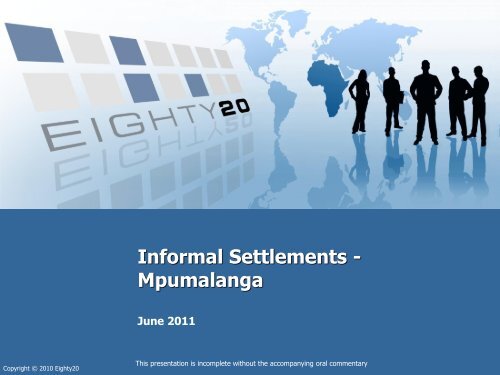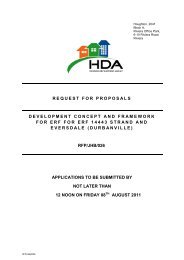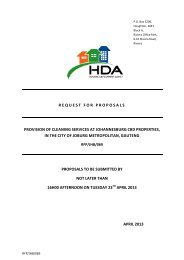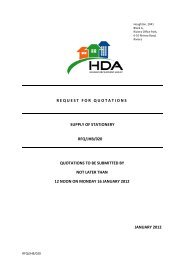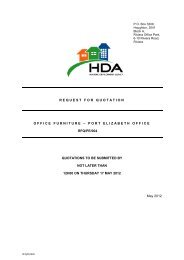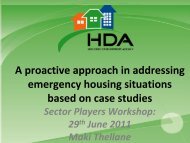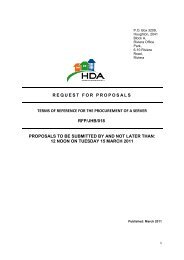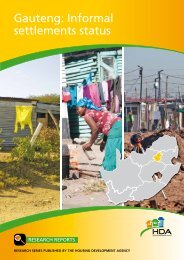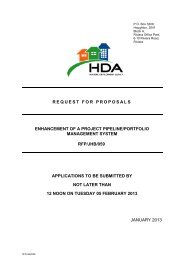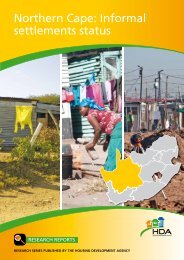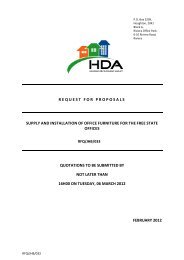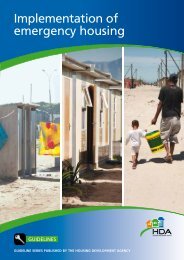Informal settlements data - Mpumalanga - Housing Development ...
Informal settlements data - Mpumalanga - Housing Development ...
Informal settlements data - Mpumalanga - Housing Development ...
Create successful ePaper yourself
Turn your PDF publications into a flip-book with our unique Google optimized e-Paper software.
<strong>Informal</strong> Settlements -<br />
<strong>Mpumalanga</strong><br />
June 2011<br />
Copyright © 2010 Eighty20<br />
This presentation is incomplete without the accompanying oral commentary
2<br />
Agenda<br />
Data Sources<br />
Number and Size of <strong>Informal</strong> Settlements<br />
Profiling <strong>Informal</strong> Settlements
3<br />
Data sources<br />
Census 2001<br />
Household <strong>data</strong><br />
Community Survey: Survey of<br />
246,618 households<br />
General Household Survey (Persons<br />
<strong>data</strong>base): Survey of 94,263 people<br />
General Household Survey<br />
(Households <strong>data</strong>base): Survey of<br />
25,303 households<br />
Income and Expenditure Survey<br />
2005/6: Survey of 21,144 households<br />
Settlement <strong>data</strong>: National<br />
Dwelling Frame <strong>data</strong>: Stats SA<br />
<strong>Informal</strong> Settlements Atlas: NDHS<br />
LaPsis: HDA<br />
Eskom Spot Building Count<br />
Settlement <strong>data</strong>: Provincial and<br />
Municipal<br />
KZN<br />
North West<br />
City of Cape Town<br />
City of Johannesburg<br />
Ekurhuleni<br />
eThekwini
4<br />
Household <strong>data</strong> is generated by the Census and by surveys<br />
Definition of an<br />
informal<br />
settlement<br />
• An unplanned settlement on land which has not been surveyed or proclaimed as<br />
residential, consisting mainly of informal dwellings (shacks)<br />
• <strong>Informal</strong> dwelling: A makeshift structure not erected according to approved architectural<br />
plans<br />
Data coverage<br />
• Data spans all of South Africa<br />
• Census 2001, and surveys (Community Survey 2007, IES 2005/6, 2002-2009 GHS)<br />
• Data available: Demographics, services, income, expenditure, assets, dwelling, tenure,<br />
etc.<br />
Methodology<br />
• Census 2001<br />
‣ Country divided up into Enumeration Areas consisting of a number of dwellings. EAs<br />
are classified as (inter alia) urban informal and urban formal<br />
• GHS<br />
‣ The sample frame is based on Census 2001 EA level <strong>data</strong><br />
‣ This has been augmented throughout the past decade through additional listings,<br />
including work done for the Community Survey in 2007<br />
‣ There are continuous changes across Primary Sampling Units (PSUs)<br />
‣ Three different sample designs were used over the years: 2002-2004, 2005-2007,<br />
2008-present<br />
‣ Sample may contain a bias toward older, more established <strong>settlements</strong> if the sample<br />
design does not explicitly incorporate newer informal <strong>settlements</strong>
Issue 1: Finding a proxy indicator in surveys<br />
Census <strong>data</strong> contains two candidate indicators to identify<br />
households who live in informal <strong>settlements</strong>. Later surveys<br />
do not provide EA level characterisations. A proxy indicator<br />
based on the dwelling type is therefore used<br />
5<br />
Definition of<br />
informal<br />
settlement:<br />
“An unplanned<br />
settlement on land<br />
which has not<br />
been surveyed or<br />
proclaimed as<br />
residential,<br />
consisting mainly<br />
of informal<br />
dwellings (shacks)<br />
EA: <strong>Informal</strong><br />
Settlement<br />
60 541<br />
(8% of MP<br />
households)<br />
Main dwelling:<br />
<strong>Informal</strong><br />
dwelling/ shack<br />
not in backyard<br />
92 496<br />
(12% of MP<br />
households)<br />
Definition of<br />
informal dwelling:<br />
“A makeshift<br />
structure not<br />
erected according to<br />
approved<br />
architectural plans”<br />
Source: Census 2001
Issue 1: Finding a proxy indicator in surveys<br />
Census <strong>data</strong> contains two candidate indicators to identify<br />
households who live in informal <strong>settlements</strong>. Later surveys<br />
do not provide EA level characterisations. A proxy indicator<br />
based on the dwelling type is therefore used<br />
6<br />
Total households who live in an informal<br />
settlement OR in a shack not in a backyard:<br />
115 713<br />
Definition of informal<br />
settlement:<br />
“An unplanned settlement<br />
on land which has not been<br />
surveyed or proclaimed as<br />
residential, consisting mainly<br />
of informal dwellings<br />
(shacks)<br />
EA: <strong>Informal</strong><br />
Settlement<br />
60 541<br />
(8% of MP<br />
households)<br />
37 323<br />
(5% of MP<br />
households)<br />
Main dwelling:<br />
<strong>Informal</strong><br />
dwelling/ shack<br />
not in backyard<br />
92 496<br />
(12% of MP<br />
households)<br />
Definition of informal<br />
dwelling:<br />
“A makeshift structure<br />
not erected according to<br />
approved architectural<br />
plans”<br />
62% of households who live in EAs classified as<br />
<strong>Informal</strong> Settlements, live in shacks not in<br />
backyards<br />
40% of households who live in shacks not in<br />
backyards, live in EAs classified as <strong>Informal</strong><br />
Settlements<br />
Source: Census 2001
Source: Census 2001<br />
Note: Formal dwelling includes flat in a block of flats, dwelling on a separate stand, backyard dwelling, room/flatlet, and town/cluster/semidetached<br />
house<br />
Issue 1: Finding a proxy indicator in surveys<br />
40% of households in <strong>Mpumalanga</strong> who live in shacks not in<br />
backyards, live in EAs classified as <strong>Informal</strong> Settlements.<br />
62% of households in <strong>Mpumalanga</strong> who live in <strong>Informal</strong><br />
Settlement EAs, live in shacks not in backyards<br />
7<br />
EA breakdown for shacks not in<br />
backyards<br />
(<strong>Mpumalanga</strong>)<br />
<strong>Housing</strong> type breakdown for <strong>Informal</strong><br />
Settlement EAs<br />
(<strong>Mpumalanga</strong>)<br />
<strong>Informal</strong><br />
Settlement,<br />
40%<br />
Urban<br />
Settlement,<br />
28%<br />
Tribal<br />
Settlement,<br />
19%<br />
Farm, 7%<br />
Shack not in<br />
backyard,<br />
62%<br />
Formal<br />
dwelling,<br />
18%<br />
Traditional<br />
dwelling,<br />
13%<br />
Other areas,<br />
6%<br />
Other, 2%<br />
Shack in<br />
backyard,<br />
5%
Issue 2: Sample sizes<br />
Sample sizes across <strong>data</strong> sources differ. In some cases these<br />
limit the extent to which <strong>data</strong> can be interrogated. While<br />
there is updated GHS <strong>data</strong> from 2009, the Community Survey<br />
is the ‘preferred’ <strong>data</strong> source given its sample size<br />
8<br />
Census 2001 Community Survey 2007<br />
Income and Expenditure<br />
Survey 2005/6<br />
General Household Survey<br />
2009<br />
Total number<br />
of households<br />
Total number<br />
of households<br />
living in shacks<br />
not in a<br />
backyard<br />
Households<br />
living in<br />
informal<br />
settlement EAs<br />
Total survey<br />
sample size<br />
Sample size for<br />
households<br />
living in shacks<br />
not in a<br />
backyard<br />
Total survey<br />
sample size<br />
Sample size for<br />
households<br />
living in shacks<br />
not in a<br />
backyard<br />
Total survey<br />
sample size<br />
Sample size for<br />
households<br />
living in shacks<br />
not in a<br />
backyard<br />
<strong>Mpumalanga</strong> 783 517 92 496 60 541 16 896 1 652 1 687 203 2 430 155<br />
Source: Census 2001 (10% sample), Community Survey 2007, IES 2005/6, GHS 2009; Household <strong>data</strong>bases
9<br />
Other issues to look out for when using survey <strong>data</strong><br />
Sampling bias<br />
• Survey samples are drawn from a master table based on Census 2001 which was updated<br />
for the 2007 Community Survey<br />
• If Stats SA does not know about a settlement (or if the sampling frame has not been<br />
updated) the settlement will not be surveyed<br />
Response bias<br />
• There may be some incentive for households to respond in certain ways to certain<br />
questions. For instance, this may happen if the household believes there is a „right‟<br />
answer or if they think the <strong>data</strong> will be used for a particular purpose<br />
Interpretation of<br />
responses<br />
• The surveys are not designed with informal <strong>settlements</strong> in mind. This makes some <strong>data</strong><br />
difficult to interpret
10<br />
Dwelling Frame Count for Census 2011: Stats SA<br />
Dwelling frame<br />
overview<br />
• The Dwelling Frame is a register of the spatial location of dwelling units and other<br />
structures. It is used to demarcate Enumeration Areas (EAs) for the 2011 Census<br />
• An EA is the smallest piece of land into which the country is divided for enumeration, of a<br />
size suitable for one fieldworker in an allocated period of time<br />
• EAs typically contain between 100 and 250 households. The acceptable range in dwelling<br />
unit count per <strong>Informal</strong> Residential EA is 151-185 (Ideal: 168) with no geographic size<br />
constraint<br />
• The Dwelling Frame has been collated since 2005 and is around 70% complete<br />
Data coverage<br />
• There are 71 sub-places in <strong>Mpumalanga</strong> with at least one EA classified as “<strong>Informal</strong><br />
Residential”, totalling 277 EAs and covering a total area of 81.21 square kilometres<br />
• There are Dwelling Frame estimates for 42 (59%) of these “<strong>Informal</strong> Residential” EAs,<br />
totalling 13,840 Dwelling Frames<br />
Comments<br />
• A dwelling frame is not the same as a dwelling or a household<br />
• The <strong>data</strong>set contains coordinates for all sub-places where there is at least one informal<br />
residential EA
11<br />
2009/2010 <strong>Informal</strong> Settlements Atlas: NDHS<br />
Definition of<br />
informal<br />
settlement<br />
• The 2009 National <strong>Housing</strong> Code‟s <strong>Informal</strong> Settlement Upgrading Programme identifies<br />
informal <strong>settlements</strong> on the basis of the following characteristics:<br />
‣ Illegality and informality;<br />
‣ Inappropriate locations;<br />
‣ Restricted public and private sector investment;<br />
‣ Poverty and vulnerability; and<br />
‣ Social stress<br />
Data coverage<br />
• 227 informal settlement polygons in <strong>Mpumalanga</strong><br />
Methodology<br />
• Combination of aerial photography, satellite imagery and discussions with municipalities<br />
to identify informal settlement polygons<br />
• Images are from different years up to 2006<br />
• Data gathering methods vary depending on area (complete <strong>data</strong> from municipality,<br />
and/or identification from imagery and manual verification)<br />
• Assisted by AfriGIS<br />
Comments<br />
• Given that some of the imagery is a number of years old, the status of informal<br />
<strong>settlements</strong> may not be accurately reflected<br />
• A critical requirement of the Atlas project is that settlement level <strong>data</strong> is regularly<br />
maintained and updated
12<br />
LaPsis: HDA<br />
Definition of<br />
informal<br />
settlement<br />
• The 2009 National <strong>Housing</strong> Code‟s <strong>Informal</strong> Settlement Upgrading Programme identifies<br />
informal <strong>settlements</strong> on the basis of the following characteristics:<br />
‣ Illegality and informality;<br />
‣ Inappropriate locations;<br />
‣ Restricted public and private sector investment;<br />
‣ Poverty and vulnerability; and<br />
‣ Social stress<br />
Data coverage<br />
• 246 informal <strong>settlements</strong> in <strong>Mpumalanga</strong><br />
• System includes cadastre, ownership, title documents and deeds, administrative<br />
boundaries, access to services (toilets, water, electricity) and points of interest (schools,<br />
transport)<br />
• None of the informal <strong>settlements</strong> have a household/shack count<br />
Methodology<br />
• Data supplied by the provinces<br />
• The <strong>data</strong> was collected in 2009<br />
• LaPsis will be updated after further work on the informal <strong>settlements</strong> layer by the HDA in<br />
2011
13<br />
Spot Building Count: Eskom<br />
Definition of<br />
informal<br />
settlement<br />
• Where <strong>settlements</strong> are too dense to determine the number of structures given the<br />
resolution of the satellite imagery the area is categorised as a „Dense <strong>Informal</strong>‟ area.<br />
These areas are often informal <strong>settlements</strong> although Eskom does not have a specific<br />
definition in that regard<br />
• Areas are demarcated as a polygon<br />
Data coverage<br />
• 75 Dense <strong>Informal</strong> polygons in <strong>Mpumalanga</strong>, covering a total area of 7.8 square<br />
kilometres<br />
• No dwelling count is provided<br />
Methodology<br />
• Based on satellite imagery
14<br />
Community-based enumeration: CORC<br />
Overview of<br />
CORC<br />
• CORC is an NGO that operates in all provinces across the country<br />
• It aims to provide support to “networks of communities to mobilise themselves around<br />
their own resources and capacities”<br />
• It profiles <strong>settlements</strong> in order to provide a fact base to enable communities to develop a<br />
strategy and negotiate with the State with regard to service provision and upgrading<br />
Methodology<br />
• Surveys have been conducted in areas across the country by community members in<br />
these <strong>settlements</strong><br />
• Community members are trained by CORC and are provided with a basic stipend to<br />
enable them to do their work<br />
• Improvements are made to questionnaires using community consultation and<br />
professional verification
15<br />
Agenda<br />
Data Sources<br />
Number and Size of <strong>Informal</strong> Settlements<br />
Profiling <strong>Informal</strong> Settlements
16<br />
Census <strong>data</strong> at a municipal level is summarised below for<br />
municipalities with households in informal settlement EAs<br />
Households living in <strong>Informal</strong> Settlement EAs: <strong>Mpumalanga</strong><br />
Municipality<br />
Number of HH in <strong>Informal</strong> Settlement EA<br />
% of HH in municipality/province that<br />
live in <strong>Informal</strong> Settlement EAs<br />
Bohlabela (now eliminated) 0 0%<br />
Ehlanzeni 9 317 3.9%<br />
Gert Sibande (formerly Govan Mbeki) 31 924 14.4%<br />
Nkangala 18 874 7.3%<br />
OTHER* 425 -<br />
<strong>Mpumalanga</strong> 60 541 7.7%<br />
Source: Census 2001<br />
Note: NUSP estimate reported by the KZN Department of Human Settlements<br />
Note: The 12 th amendment to the Constitution in December 2005 reduced the number of districts from 53 to 52 (Bohlabela was eliminated),<br />
and also eliminated cross-border districts (each district is now completely contained within a province). With regards to <strong>Mpumalanga</strong>,<br />
Sekhukune Cross Boundary was in 2001 also in Limpopo province, and Metsweding was also in Gauteng province; now neither is in<br />
<strong>Mpumalanga</strong>. The households in these two districts are included in „OTHER‟ above.
Number of households (000s)<br />
17<br />
Estimates of the number of households who live in shacks<br />
not in backyards vary, sometimes quite significantly<br />
1 000 300<br />
900<br />
250<br />
800<br />
783<br />
940<br />
3%<br />
1 000 300<br />
900<br />
250<br />
800<br />
768<br />
Households by dwelling type<br />
(<strong>Mpumalanga</strong>)<br />
795<br />
769<br />
808<br />
877<br />
909<br />
943<br />
978<br />
4%<br />
1 000 300<br />
900<br />
250<br />
800<br />
880<br />
200<br />
200<br />
200<br />
150<br />
150<br />
150<br />
100<br />
100<br />
100<br />
50 93 50<br />
50<br />
86<br />
89<br />
100<br />
-1%<br />
75<br />
72<br />
56<br />
60<br />
70 64 -5%<br />
0<br />
12% 9%<br />
0<br />
12% 9% 7% 12% 7% 8% 7% 7%<br />
0<br />
12%<br />
Census CS 2007<br />
GHS GHS GHS GHS GHS GHS GHS GHS<br />
IES 2005/6<br />
2001<br />
2002 2003 2004 2005 2006 2007 2008 2009<br />
2001: Number of<br />
households in <strong>Informal</strong><br />
Settlement EAs:<br />
60 541 (8%)<br />
HH lives in shack not in backyard<br />
Total households<br />
Source: Census 2001 (full <strong>data</strong>base), Community Survey 2007, IES 2005/6, GHS 2002 – 2009 (reweighted)<br />
Note: Dashed line indicates new sample designs for GHS (2002-2004, 2005-2007, 2008-2009)
Number of households (000s)<br />
Number of households (000s)<br />
Thousands<br />
18<br />
Nkangala has the largest proportion of households that live<br />
in a shack not in a backyard compared to other district<br />
municipalities in <strong>Mpumalanga</strong><br />
Number of households that live in shacks<br />
(<strong>Mpumalanga</strong>)<br />
Shack not in backyard<br />
Shack in backyard<br />
60<br />
18%<br />
10<br />
9<br />
5%<br />
50<br />
51<br />
17%<br />
16%<br />
14%<br />
9<br />
8<br />
4%<br />
8<br />
4%<br />
4%<br />
40<br />
30<br />
20<br />
10%<br />
25<br />
12%<br />
10%<br />
8%<br />
6%<br />
% of households<br />
7<br />
6<br />
5<br />
4<br />
3<br />
3%<br />
6<br />
2%<br />
3%<br />
3%<br />
2%<br />
2%<br />
% of households<br />
10<br />
10<br />
3%<br />
4%<br />
2%<br />
2<br />
1<br />
1%<br />
1%<br />
0<br />
Nkangala Gert Sibande Ehlanzeni<br />
0%<br />
0<br />
Gert Sibande Nkangala Ehlanzeni<br />
0%<br />
Source: Community Survey 2007 HH
19<br />
The number of households in a shack not in a backyard in<br />
Nkangala had the highest CAGR (6%)<br />
Compound annual growth (2001 - 2007)<br />
(Household lives in a shack not in a backyard, household lives in a shack in a backyard, <strong>Mpumalanga</strong>)<br />
Nkangala<br />
8 124<br />
0%<br />
Ehlanzeni<br />
10 447<br />
-7%<br />
Gert Sibande<br />
25 133<br />
-6%<br />
Ehlanzeni<br />
5 989<br />
0%<br />
Gert Sibande<br />
9 444<br />
2%<br />
Nkangala<br />
50 681<br />
6%<br />
-8%<br />
-6%<br />
-4%<br />
Source: Census 2001 (10% sample) and Community Survey 2007<br />
Note: 2005 provincial borders have been used<br />
* Sample size is less than 40<br />
-2% 0%<br />
2%<br />
HH lives in shack not in backyard<br />
4% 6%<br />
HH lives in backyard shack
Number of households (000s)<br />
20<br />
The proportion of households in <strong>Mpumalanga</strong> that live in<br />
shacks not in backyards has slightly decreased from 12% to<br />
9%<br />
Type of main dwelling<br />
(<strong>Mpumalanga</strong>, Thousands)<br />
CAGR<br />
1 000<br />
940<br />
3.1%<br />
900<br />
800<br />
700<br />
783<br />
95 (12%)<br />
13 (2%)<br />
66 (7%)<br />
51 (5%)<br />
86 (9%)<br />
13 (1%)<br />
13 (1%)<br />
24 (3%)<br />
-5.8%<br />
0.1%<br />
Traditional dwelling<br />
Flat in a block of flats<br />
600<br />
60 (8%)<br />
17 (2%)<br />
24 (3%)<br />
-4.0%<br />
House/flat/room, in backyard<br />
500<br />
93 (12%)<br />
-2.7%<br />
Other<br />
400<br />
300<br />
687 (73%)<br />
-0.6%<br />
<strong>Informal</strong> dwelling/shack, in<br />
backyard<br />
200<br />
100<br />
0<br />
480 (61%)<br />
Census 2001 Community Survey 2007<br />
-1.2%<br />
6.1%<br />
<strong>Informal</strong> dwelling/shack, NOT<br />
in backyard, e.g. in an<br />
informal/squatter settlement<br />
House on a separate stand or<br />
town/cluster/semi-detached<br />
house<br />
Source: Census 2001 (full <strong>data</strong>base), Community Survey 2007; Household <strong>data</strong>bases<br />
Note: Other includes room/flatlet on a shared property, caravan/tent, private ship/boat, collective living quarters, other
21<br />
Estimating the number of informal <strong>settlements</strong> and the<br />
number of households living in informal <strong>settlements</strong><br />
Bohlabela (now<br />
eliminated)<br />
LaPsis:<br />
<strong>Informal</strong><br />
<strong>settlements</strong><br />
Number of informal <strong>settlements</strong><br />
Atlas:<br />
<strong>Informal</strong><br />
settlement<br />
polygons<br />
StatsSA: Sub<br />
Places with<br />
at least one<br />
EA classified<br />
as “<strong>Informal</strong><br />
Residential”<br />
Eskom:<br />
Polygons<br />
classified<br />
as “Dense<br />
<strong>Informal</strong>”<br />
Number of households in<br />
informal <strong>settlements</strong><br />
Census<br />
CS 2007:<br />
Census<br />
2001: HH in<br />
HH in<br />
2001: HH in<br />
informal<br />
shacks not<br />
shacks not<br />
settlement<br />
in<br />
in backyards<br />
EA<br />
backyards<br />
- - 0 0<br />
Ehlanzeni 82 75 9 317 15 963 10 447<br />
Gert Sibande<br />
(formerly Govan<br />
Mbeki)<br />
109 105 31 924 37 389 25 133<br />
Nkangala 55 47 18 874 35 297 50 681<br />
OTHER - - 425 3 846<br />
<strong>Mpumalanga</strong> 246 227 71 75 60 541 92 496 86 261<br />
* Households in informal <strong>settlements</strong> to be upgraded between 2010/11 and<br />
2013/14 (Outcome 8): 26 480 in <strong>Mpumalanga</strong>
22<br />
Agenda<br />
Data Sources<br />
Number and Size of <strong>Informal</strong> Settlements<br />
Profiling <strong>Informal</strong> Settlements
23<br />
Agenda<br />
Basic living conditions and access to services<br />
Profile of households and families<br />
Income, expenditure and well-being<br />
Age of dwellings and permanence<br />
<strong>Housing</strong> waiting lists<br />
Health and vulnerability<br />
Education
The percentage of households in shacks not in backyards with<br />
no toilet facilities decreased in 2007 from 2001, and the<br />
percentage of households receiving piped water in their<br />
dwelling increased<br />
24<br />
Toilet facility<br />
(HH lives in an informal dwelling / shack not in backyard,<br />
<strong>Mpumalanga</strong>)<br />
Source of drinking water<br />
(HH lives in an informal dwelling / shack not in backyard,<br />
<strong>Mpumalanga</strong>)<br />
100%<br />
80%<br />
20%<br />
3%<br />
12%<br />
6%<br />
3%<br />
100%<br />
80%<br />
4%<br />
16%<br />
14%<br />
8%<br />
60%<br />
12%<br />
19%<br />
23%<br />
60%<br />
30%<br />
42%<br />
40%<br />
40%<br />
20%<br />
46%<br />
56%<br />
20%<br />
51%<br />
35%<br />
0%<br />
Census 2001<br />
Community Survey<br />
2007<br />
Pit latrine Flush Bucket latrine Other* None<br />
0%<br />
Census 2001<br />
Piped water on community stand<br />
Other**<br />
Source: Census 2001 and Community Survey 2007 HH<br />
* Other toilet- includes Chemical toilet and Dry toilet facility<br />
** Other water source- incudes Borehole, Flowing water, Stagnant water, Well, Spring and Other<br />
Community Survey<br />
2007<br />
Piped water in yard<br />
Piped water in dwelling
25<br />
Access to electricity used for lighting increased from 2001 to<br />
2007, weekly refuse removal by a local authority or private<br />
company decreased slightly<br />
Energy used for lighting<br />
(HH lives in an informal dwelling / shack not in backyard,<br />
<strong>Mpumalanga</strong>)<br />
100%<br />
80%<br />
60%<br />
1% 1%<br />
8% 9%<br />
36%<br />
45%<br />
Refuse collection<br />
(HH lives in an informal dwelling / shack not in backyard,<br />
<strong>Mpumalanga</strong>)<br />
100%<br />
80%<br />
60%<br />
1% 1%<br />
4% 2%<br />
8%<br />
12%<br />
38%<br />
37%<br />
40%<br />
40%<br />
20%<br />
55%<br />
45%<br />
20%<br />
45% 53%<br />
0%<br />
Census 2001<br />
Community Survey<br />
2007<br />
Candles Electricity Paraffin Other*<br />
Source: Census 2001 and Community Survey 2007 HH<br />
* Other includes Gas, Solar and Other<br />
** In the Community Survey these include refuse removed by private company<br />
0%<br />
Census 2001 Community Survey<br />
2007<br />
Removed by local authority less often<br />
Communal refuse dump<br />
No rubbish disposal<br />
Removed by local authority at least once a week<br />
Own refuse dump
26<br />
73% of households living in shacks not in backyards in<br />
<strong>Mpumalanga</strong> receive at least one service<br />
Access to services<br />
(HH lives in an informal dwelling / shack not in backyard, <strong>Mpumalanga</strong>)<br />
Piped water in dwelling or yard<br />
57%<br />
Use electricity for lighting<br />
44%<br />
Refuse collected by municipality<br />
37%<br />
Have a flush toilet<br />
23%<br />
Have at least one of the above<br />
73%<br />
Have all of the above<br />
15%<br />
Source: CS 2007HH
27<br />
73% of households living in shacks not in backyards in<br />
<strong>Mpumalanga</strong> receive at least one service<br />
Access to services: <strong>Mpumalanga</strong><br />
(HH lives in an informal dwelling / shack not in backyard)<br />
Refuse collected by<br />
municipality<br />
Piped/tap water in<br />
dwelling or yard<br />
Use electricity for<br />
lighting<br />
Flush toilet<br />
South Africa 51% 38% 42% 22%<br />
<strong>Mpumalanga</strong> 37% 57% 45% 23%<br />
Source: Community Survey 2007<br />
Note: Green: 50%+, Yellow: 25%-49%, Red:
28<br />
According to the 2007 Community Survey, 40% of<br />
households in shacks not in backyards in <strong>Mpumalanga</strong> have a<br />
television. 73% have at least one cell phone in the household<br />
Assets in household<br />
(HH lives in an informal dwelling / shack not in backyard; <strong>Mpumalanga</strong>)<br />
Landline telephone<br />
1% *<br />
Computer<br />
2% *<br />
Refrigerator<br />
33%<br />
Television<br />
40%<br />
Radio<br />
70%<br />
Cell phone<br />
73%<br />
Source: Community Survey 2007 HH<br />
Note*: Small sample sizes, less than 40 observations
29<br />
Agenda<br />
Basic living conditions and access to services<br />
Profile of households and families<br />
Income, expenditure and well-being<br />
Age of dwellings and permanence<br />
<strong>Housing</strong> waiting lists<br />
Health and vulnerability<br />
Education
30<br />
Household heads in shacks not in backyards are younger<br />
than those in formal dwellings<br />
Demographics of household head<br />
(Lives in an informal dwelling / shack not in backyard versus those living in a formal dwelling, <strong>Mpumalanga</strong>)<br />
Gender<br />
Age group<br />
100%<br />
80%<br />
48%<br />
52%<br />
100%<br />
80%<br />
3%<br />
8%<br />
14%<br />
2%<br />
5%<br />
5%<br />
8%<br />
12%<br />
60%<br />
60%<br />
20% 15%<br />
40%<br />
40%<br />
20%<br />
52%<br />
48%<br />
20%<br />
51% 55%<br />
0%<br />
Shack not in backyard<br />
Formal dwelling<br />
0%<br />
Shack not in backyard<br />
Formal dwelling<br />
Source: CS 2007<br />
Male<br />
Female<br />
Source: CS 2007 Persons <strong>data</strong>base<br />
31<br />
114 000 people (39%) living in a shack not in a backyard in<br />
<strong>Mpumalanga</strong> aged 17 or below<br />
Children aged 17 or below living in shacks not in backyards<br />
(Live in an informal dwelling / shack not in backyard, <strong>Mpumalanga</strong>)<br />
31 182<br />
27%<br />
44 558<br />
39%<br />
21 398<br />
19%<br />
16 435<br />
15%<br />
Total children aged 17 or below: 113 573<br />
In 2007, 25% of households living in shacks not in backyards<br />
in <strong>Mpumalanga</strong> were single person households; this is up<br />
from 22% in 2001. In 2007, 13% of households that live in a<br />
shack not in a backyard in <strong>Mpumalanga</strong> live in crowded<br />
conditions<br />
32<br />
Size of household and over crowding<br />
(HH lives in informal dwelling / shack not in backyard, <strong>Mpumalanga</strong>)<br />
Total number of rooms Household size Over crowding*<br />
54%<br />
36%<br />
23%<br />
25%<br />
87% 13%<br />
23%<br />
38%<br />
1 2-3 4+<br />
1 2-3 4+<br />
Average HH size<br />
HH lives in shack not in backyard: 3.2<br />
HH lives in formal dwelling: 4.1<br />
All <strong>Mpumalanga</strong> HH: 3.9<br />
Source: CS 2007 Households<br />
* A household is considered over-crowded if there are more than two people per room<br />
Note: 22% of South African households living in shacks not in backyards live in over-crowded conditions<br />
No<br />
Yes
33<br />
Average household size<br />
Average household size<br />
Shack not in backyard<br />
Formal dwelling<br />
2001 2007 2001 2007<br />
South Africa 3.2 3.2 3.8 3.8<br />
<strong>Mpumalanga</strong> 3.5 3.2 4.1 4.1<br />
Source: Census 2001, Community Survey 2007
34<br />
Agenda<br />
Basic living conditions and access to services<br />
Profile of households and families<br />
Income, expenditure and well-being<br />
Age of dwellings and permanence<br />
<strong>Housing</strong> waiting lists<br />
Health and vulnerability<br />
Education
According to the IES, 79% of households in shacks not in<br />
backyards in <strong>Mpumalanga</strong> earned less than R3,500 in 2006<br />
(2006 Rands). Inflating the numbers to 2010 Rands (and<br />
assuming no real shift in income) 74% of households earn<br />
less than R3,500 per month<br />
Household monthly income<br />
(HH lives in an informal dwelling / shack not in backyard; <strong>Mpumalanga</strong>)<br />
35<br />
Income in 2006 Rands<br />
Income in 2010 Rands<br />
The proportion<br />
that have R3 500+<br />
is higher than the<br />
whole country<br />
20%<br />
30%<br />
26%<br />
20% *<br />
22%<br />
29%<br />
21%<br />
32%<br />
< R850 R850 - R1 499 R1 500 - R3 499 R3 500 +<br />
Source: IES 2005/6<br />
Note: House or semi-detached house includes dwelling/brick structure located on a separate stand/yard/farm, and town/cluster/semidetached<br />
houses. Backyard dwelling includes dwelling/flat/room in backyard. Other includes room/flatlet or larger dwelling/servants‟<br />
quarters/granny flat, unit in retirement village, workers‟ hostel, family unit, caravan/tent, other and unspecified<br />
Note*: Small sample sizes, less than 40 observations
Percentage of households<br />
36<br />
Around 12% of households in <strong>Mpumalanga</strong> earning less than<br />
R3,500 (in 2006 Rands) live in shacks not in backyards<br />
Percentage of households that live in shacks not in backyards<br />
(By monthly household income; <strong>Mpumalanga</strong>)<br />
20%<br />
15%<br />
14%<br />
11% 11%<br />
10%<br />
9%<br />
5%<br />
0%<br />
< R850 R850 - R1 499 R1 500 - R3 499 R3 500 +<br />
Source: IES 2005/6<br />
Note: Income is nominal, weighted to April 2006 Rands
Percentage of households<br />
37<br />
In 2007, the labour force participation rate for adults in<br />
<strong>Mpumalanga</strong> living in shacks not in backyards was 61%,<br />
higher than the provincial average of 52%<br />
100%<br />
Labour force participation rates<br />
(Adults 15+)<br />
80%<br />
60%<br />
40%<br />
64%<br />
42%<br />
54% 55%<br />
67%<br />
66%<br />
54%<br />
47%<br />
61% 61%<br />
35%<br />
52%<br />
64%<br />
54%<br />
51%<br />
49%<br />
71%<br />
63%<br />
63%<br />
53%<br />
20%<br />
0%<br />
Eastern Cape Free State Gauteng KwaZulu-<br />
Natal<br />
Limpopo <strong>Mpumalanga</strong> North West Northern<br />
Cape<br />
Western<br />
Cape<br />
South Africa<br />
Adult lives in shack not in backyard<br />
All adults (incl. shack not in backyard)<br />
Source: General Household Survey Workers 2007 (adults 15+)
Percentage of households<br />
38<br />
In 2007, the unemployment rate for <strong>Mpumalanga</strong> adults<br />
living in shacks not in backyards was 22%, below the<br />
provincial unemployment rate of 29%<br />
50%<br />
Unemployment rates<br />
(Adults 15+)<br />
43%<br />
44%<br />
40%<br />
37%<br />
30%<br />
29%<br />
27%<br />
28%<br />
22%<br />
23%<br />
28%<br />
30%<br />
28%<br />
22%<br />
29%<br />
34%<br />
25%<br />
28%<br />
26%<br />
32%<br />
25%<br />
20%<br />
19%<br />
10%<br />
0%<br />
Eastern<br />
Cape<br />
Free State Gauteng KwaZulu-<br />
Natal<br />
Limpopo <strong>Mpumalanga</strong> North West Northern<br />
Cape<br />
Western<br />
Cape<br />
South Africa<br />
Adult lives in shack not in backyard<br />
All adults (incl. shack not in backyard)<br />
Source: General Household Survey Workers 2007 (adults 15+)
39<br />
Most employed individuals in shacks not in backyards in<br />
<strong>Mpumalanga</strong> use taxis or buses and take less than half an<br />
hour to get to work<br />
Note: 53,288 in shacks not in<br />
backyards in <strong>Mpumalanga</strong> are<br />
employed (28%)<br />
Usual mode of transport to work<br />
(Live in an informal dwelling / shack not in backyard, Employed, <strong>Mpumalanga</strong>)<br />
22 615<br />
43%<br />
8 721<br />
16%<br />
14 820<br />
28%<br />
7 132<br />
13%<br />
In formal dwellings the<br />
most common form of<br />
transport to work in<br />
<strong>Mpumalanga</strong> are private<br />
vehicles at 34%<br />
Taxi/Bus Walking/Bicycle/Motorcycle Private Vehicle* Office is at home*<br />
Time taken to Work<br />
31 min<br />
+*, 44%<br />
0 - 30<br />
min, 56%<br />
Source: GHS 2009 Persons<br />
Note: Travel time refers to travelling in one direction using their normal type of transport<br />
Note: If more than one type of transport was used, then the type of transport that covers the most distance is classified as the normal mode<br />
of transport<br />
Note*: small sample size, less than 40 observations<br />
Percentage of Commuting workers
40<br />
Main income sources differ from other dwelling types<br />
Main source of income<br />
(<strong>Mpumalanga</strong>)<br />
<strong>Informal</strong> dwellings/shack<br />
not in backyard (e.g.<br />
informal settlement)<br />
56%<br />
11%*<br />
11%*<br />
21%*<br />
House or semi-detached<br />
house<br />
54%<br />
10%<br />
13%<br />
23%<br />
Traditional dwelling<br />
54%<br />
6%*<br />
10%*<br />
30%<br />
All MP households<br />
56%<br />
10%<br />
12%<br />
22%<br />
Salaries/wages/commission Pensions and grants Other Remittances No income *<br />
Source: GHS 2009 HH<br />
Note: All households also includes backyard dwelling, room/flatlet on a property or a larger servants quarters/dwelling, caravan/tent,<br />
flat/apartment, informal dwelling/shack in backyard, other<br />
* Sample size small (
41<br />
The proportion of households that transfer maintenance or<br />
remittances for shacks not in backyards is around the same<br />
as the average for <strong>Mpumalanga</strong> households as a whole<br />
Maintenance of / remittance to family members and dependants living elsewhere<br />
(In cash or in kind, <strong>Mpumalanga</strong>)<br />
<strong>Informal</strong> dwelling/shack in backyard<br />
68% *<br />
<strong>Informal</strong> dwelling/shack not in backyard<br />
38%<br />
Formal dwelling<br />
36%<br />
Traditional dwelling<br />
19% *<br />
All <strong>Mpumalanga</strong> households<br />
36%<br />
Source: IES 2005/6<br />
Note: Formal housing includes dwelling or brick structure on a separate stand/yard/farm, flat/apartment in a block of flats, room/flatlet or a<br />
larger dwelling/servants quarters/granny flat, town/cluster/semi-detached house, workers‟ hostel or family unit, and unit in retirement village<br />
Note: All households also includes backyard dwelling, caravan/tent, other and unspecified<br />
Note: * Small sample size, less than 40 observations (not below 20)
42<br />
Various measures of deprivation indicate very high levels of<br />
poverty<br />
Measures of deprivation<br />
(<strong>Mpumalanga</strong>)<br />
50%<br />
40%<br />
42% *<br />
40% *<br />
30%<br />
31% 30% *<br />
20%<br />
23%<br />
21%<br />
23%<br />
14%<br />
10%<br />
0%<br />
Limited number of foods to<br />
feed children past year<br />
Insufficient food for children<br />
in past year<br />
Run out of food in past year<br />
Children ever go to bed<br />
hungry in past year<br />
<strong>Informal</strong> dwelling/shack not in backyard<br />
All <strong>Mpumalanga</strong> households<br />
Source: GHS 2009 HH<br />
Note: Those questions referring to children exclude those households with no children<br />
*Note: Small sample sizes, less than 40 observations (not below 20)
43<br />
Agenda<br />
Basic living conditions and access to services<br />
Profile of households and families<br />
Income, expenditure and well-being<br />
Age of dwellings and permanence<br />
<strong>Housing</strong> waiting lists<br />
Health and vulnerability<br />
Education
44<br />
The majority of people currently living in a shack not in a<br />
backyard in <strong>Mpumalanga</strong> have been living there since before<br />
2001<br />
Year person moved into this dwelling<br />
(Lives in an informal dwelling / shack not in backyard,<br />
<strong>Mpumalanga</strong>)<br />
Province lived in before moving to this dwelling*<br />
(Lives in an informal dwelling / shack not in backyard, moved in<br />
after 2001, <strong>Mpumalanga</strong>)<br />
Outside RSA: 3%<br />
2%<br />
10%<br />
65%<br />
7%<br />
1%<br />
3%<br />
MP<br />
76%<br />
5%<br />
3%<br />
2%<br />
KZN<br />
2%<br />
6%<br />
0%<br />
13%<br />
3%<br />
2007 2006<br />
2005 2004<br />
2001-2003 Born after October 2001<br />
Have not moved since October 2001<br />
Source: Community Survey 2007 Persons<br />
Note*: Sample sizes for some provinces less than 40<br />
0%
Source: GHS 2009 HH<br />
Note: The survey states that if the year is not known, the best estimate should be given. Although it is not shown here, this accounts for the<br />
very few “unspecified” responses<br />
* Sample size small (< 40)<br />
45<br />
Majority of shacks not in backyards were originally built<br />
between 2000 and 2004<br />
Year current dwelling was originally built<br />
(<strong>Mpumalanga</strong>)<br />
Shack not<br />
in backyard<br />
32%<br />
34%<br />
28%<br />
6% *<br />
1940 1990 2000<br />
2005<br />
2009<br />
House/dwelling<br />
on separate<br />
stand<br />
28% 28%<br />
28%<br />
16%<br />
1940 1990 2000<br />
2005<br />
2009
Proportion of households<br />
According to the Census 45% of both households living in a shack<br />
not in a backyard and those in backyard shacks in <strong>Mpumalanga</strong>,<br />
claim to own their dwelling. Community Survey estimates these<br />
proportions as 59% and 45% respectively<br />
Dwelling tenure across different surveys<br />
(HH lives in an informal dwelling / shack not in backyard,<br />
<strong>Mpumalanga</strong>)<br />
Total number<br />
of households 92,496<br />
86,261<br />
100%<br />
80%<br />
16%<br />
*<br />
10%<br />
30%<br />
100%<br />
80%<br />
Dwelling tenure across different surveys<br />
(HH lives in an informal dwelling / shack in backyard,<br />
<strong>Mpumalanga</strong>)<br />
24,398 23,556<br />
28%<br />
34%<br />
46<br />
60%<br />
40%<br />
60%<br />
27%<br />
20%<br />
40%<br />
40%<br />
20%<br />
45%<br />
59%<br />
20%<br />
45% 45%<br />
0%<br />
Census 2001 CS 2007<br />
0%<br />
Census 2001 CS 2007<br />
*<br />
Owned Occupied rent-free Rented<br />
Source: Census 2001 (10% sample), Community Survey 2007; Household <strong>data</strong>bases<br />
Note: The breakdown of ownership does not include “Other” due to small sample sizes
47<br />
Agenda<br />
Basic living conditions and access to services<br />
Profile of households and families<br />
Income, expenditure and well-being<br />
Age of dwellings and permanence<br />
<strong>Housing</strong> waiting lists<br />
Health and vulnerability<br />
Education
Proportion of households<br />
48<br />
According to GHS, 40% of households living in a shack not in<br />
a backyard in <strong>Mpumalanga</strong> have at least one member on the<br />
RDP waiting list<br />
Member of a household on the RDP (or state<br />
subsidised house) waiting list/demand <strong>data</strong>base<br />
(HH lives in an informal dwelling / shack not in backyard;<br />
<strong>Mpumalanga</strong>)<br />
No, 60%<br />
Yes, 40%<br />
Number of households living in a shack<br />
not in a backyard in <strong>Mpumalanga</strong>:<br />
63,655<br />
Number of households<br />
who claim to be on the<br />
RDP waiting list/demand<br />
<strong>data</strong>base<br />
(<strong>Informal</strong> dwelling/shack not in<br />
backyard; <strong>Mpumalanga</strong>):<br />
25,609<br />
Number of households<br />
that qualify for the<br />
waiting list/demand<br />
<strong>data</strong>base<br />
(<strong>Informal</strong> dwelling/shack not in<br />
backyard; <strong>Mpumalanga</strong>):<br />
27,198<br />
In which year the first person joined the<br />
waiting list/demand <strong>data</strong>base<br />
(Any member on the waiting list; HH lives in an informal<br />
dwelling / shack not in backyard; <strong>Mpumalanga</strong>)<br />
100%<br />
80%<br />
60%<br />
40%<br />
20%<br />
0%<br />
73%<br />
27%*<br />
Person A<br />
Source: GHS 2009 HH<br />
Note: To qualify for the waiting list, the household must have a household income of less than R3,500; a size of more than 1; not own another<br />
dwelling; and have no housing subsidy. Due to rounding, the percentages may not sum to 100%.<br />
* Sample size less than 40<br />
2005 - 2009<br />
1990 - 2004
67% of households living in a shack not in a backyard in<br />
<strong>Mpumalanga</strong> have a total household income of less than<br />
R3,500. 97% have not received any housing subsidy on their<br />
current or past dwellings<br />
49<br />
Household monthly income<br />
(HH lives in an informal dwelling /<br />
shack not in backyard; <strong>Mpumalanga</strong>)<br />
Household size<br />
(HH lives in an informal dwelling /<br />
shack not in backyard; <strong>Mpumalanga</strong>)<br />
<strong>Housing</strong> subsidy on current or<br />
past dwelling<br />
(HH lives in an informal dwelling / shack not<br />
in backyard; <strong>Mpumalanga</strong>)<br />
11%*<br />
3%*<br />
22%*<br />
33%<br />
30%<br />
67%<br />
37%<br />
97%<br />
< R3 500 R3 500 + Unspecified<br />
1 2 - 3 4+<br />
Yes<br />
No<br />
Source: GHS 2009 HH<br />
Note: Of the 63,655 households whose main dwelling is an informal dwelling/shack not in a backyard, 90% do not have another dwelling.<br />
The income figures are slightly different to the IES adjusted numbers. This may be due to a number of factors, such as shifts in income or a<br />
misrepresentation of the true monthly household income. Due to rounding, the percentages may not sum to 100%<br />
* Sample size is less than 40
50<br />
Agenda<br />
Basic living conditions and access to services<br />
Profile of households and families<br />
Income, expenditure and well-being<br />
Age of dwellings and permanence<br />
<strong>Housing</strong> waiting lists<br />
Health and vulnerability<br />
Education
51<br />
Access to key points of service has been mapped for some<br />
informal <strong>settlements</strong> using a 5km radius<br />
<strong>Informal</strong> <strong>settlements</strong>: Access to key facilities<br />
(<strong>Mpumalanga</strong>)<br />
Education Facilities<br />
97%<br />
Security Facilities (SAPS)<br />
40%<br />
Medical Facilities<br />
37%<br />
Transport<br />
20%<br />
Place of Worship Facilities<br />
20%<br />
Recreational Facilities<br />
11%<br />
Commercial Facilities<br />
6%<br />
Government Service Points<br />
0%<br />
Source: Department of Human Settlements (provided by HDA)<br />
Note: Data for all provinces is based on a total of 1,448 verified locations of Human Settlements, and facilities within 5km radius
Percentage of people<br />
Source: GHS 2009 Persons; Note: These questions are asked of everyone, regardless of whether they have been recently ill<br />
Note: Due to small sample sizes, not all options given in the survey are shown here * Sample size is less than 40<br />
Approximately 18% of people living a shack in a shack not in a<br />
backyard in <strong>Mpumalanga</strong> have suffered from an illness or injury<br />
in the past month. There is no significant difference when this is<br />
compared to people living in formal dwellings<br />
Population<br />
totals in<br />
segment<br />
100%<br />
80%<br />
Primary source of medical help<br />
(<strong>Mpumalanga</strong>)<br />
188,657 3,069,079<br />
2%*<br />
18%<br />
100%<br />
80%<br />
Usual means of transport to<br />
health facility<br />
(<strong>Mpumalanga</strong>)<br />
Time taken to travel to health facility<br />
using usual means of transport<br />
(<strong>Mpumalanga</strong>)<br />
188,657 3,069,079 188,657 3,069,079<br />
31%<br />
2%*<br />
17%<br />
100%<br />
80%<br />
11%<br />
20%<br />
52<br />
60%<br />
70%<br />
60%<br />
29%<br />
60%<br />
44%<br />
38%<br />
40%<br />
20%<br />
26%<br />
71%<br />
40%<br />
20%<br />
66%<br />
52%<br />
40%<br />
20%<br />
30%<br />
47%<br />
0%<br />
Shack not in<br />
backyard<br />
8%<br />
Formal dwelling<br />
0%<br />
Shack not in<br />
backyard<br />
Formal dwelling<br />
0%<br />
Shack not in<br />
backyard<br />
Formal dwelling<br />
Private doctor/specialist<br />
Clinic (Public)<br />
Walking Taxi Own transport<br />
< 15 minutes 15 - 29 mins 30 mins +<br />
Hospital (Public)
Percentage of Households<br />
53<br />
22% of households in shacks not in backyards in <strong>Mpumalanga</strong><br />
have a member who was a victim of crime in the last year<br />
30%<br />
Households who have had at least one member as a victim of crime in the last year<br />
(<strong>Mpumalanga</strong>)<br />
22%<br />
23%<br />
20%<br />
20%<br />
19%<br />
10%<br />
0%<br />
All Households Shacks not in Backyard Shacks in Backyard* Formal <strong>Housing</strong><br />
Source: GHS 2008 HH<br />
Note: Formal <strong>Housing</strong> includes Dwelling/House or brick structure, Flat/Apartments, Town/Cluster/Semi-detached house, Unit in a retirement<br />
village, Dwelling/House/Flat/Room in backyard and Room/Flatlet<br />
Note: All Households include Shacks in Backyard, Shacks not in Backyard, Formal <strong>Housing</strong>, Traditional dwellings, Caravans/Tents and other<br />
Note*: Small sample sizes, less than 40 observations<br />
Note: Crime includes Murder, Molestation, Beaten/Hurt by someone, Harassed/Threatened or Theft
54<br />
Agenda<br />
Basic living conditions and access to services<br />
Profile of households and families<br />
Income, expenditure and well-being<br />
Age of dwellings and permanence<br />
<strong>Housing</strong> waiting lists<br />
Health and vulnerability<br />
Education
Number of adults (000s)<br />
55<br />
86% of adults in shacks not in backyards in <strong>Mpumalanga</strong><br />
have less than a matric<br />
Highest level of education achieved<br />
(Live in an informal dwelling / shack not in backyard, Adults 18+, <strong>Mpumalanga</strong>)<br />
70<br />
60<br />
59<br />
50<br />
40<br />
30<br />
29<br />
20<br />
10<br />
13<br />
17<br />
?<br />
0<br />
Proportion of<br />
adults in shacks<br />
not in backyards<br />
No Schooling Primary School Some High School Matric Other/Don't<br />
Know/Unspecified*<br />
11% + 25% + 50% + 14% + 0% = 100%<br />
Source: GHS 2009 Persons<br />
Note: Other includes certificate with less than matric, diploma with less than matric and other<br />
Note: For all South African adults 18+ the highest level of education achieved is as follows: No schooling (7%), Primary school (17%),<br />
Some high school (38%), Matric (25%), Technikon/University/other post Matric (11%), Other/DK/Unspecified (2%)<br />
Note*: Small sample size, less than 40 observations<br />
0
Number of children (
57<br />
Most children in shacks not in backyards attending<br />
educational facilities in <strong>Mpumalanga</strong> walk to get there and<br />
have these institutions within 30 minutes travel<br />
Usual mode of transport to educational facility by children<br />
(Live in an informal dwelling / shack not in backyard,<br />
Children aged 5-17, <strong>Mpumalanga</strong>)<br />
Time taken to educational<br />
facilities: walking<br />
31-60 min<br />
5%*<br />
3 628<br />
8%<br />
Walking<br />
42 874<br />
92%<br />
Other forms of transport<br />
15-30 min<br />
54%<br />


